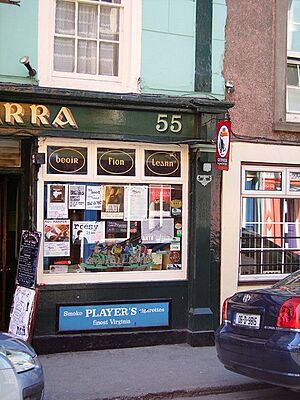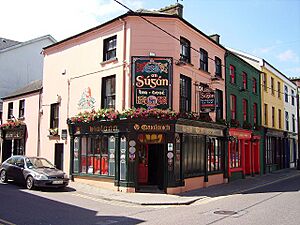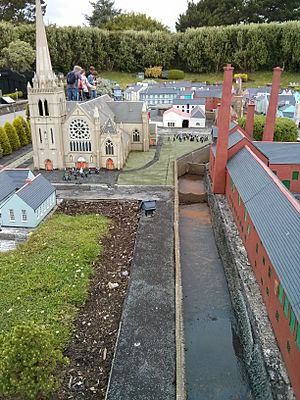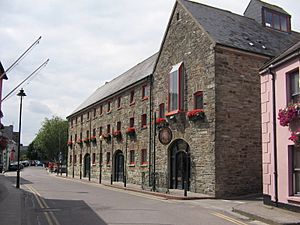Clonakilty facts for kids
Quick facts for kids
Clonakilty
Irish: Cloich na Coillte
|
|
|---|---|
|
Town
|
|
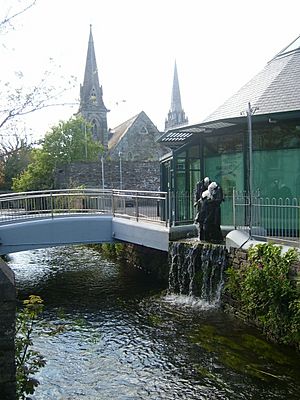
The Feagle River passes through Clonakilty
|
|
| Country | Ireland |
| Province | Munster |
| County | County Cork |
| Area | |
| • Total | 3.433 km2 (1.325 sq mi) |
| Population
(2022)
|
|
| • Total | 4,946 |
| • Density | 1,337.5/km2 (3,464/sq mi) |
| Time zone | UTC±0 (WET) |
| • Summer (DST) | UTC+1 (IST) |
| Eircode routing key |
P85
|
| Telephone area code | +353(0)23 |
| Irish Grid Reference | W381417 |
| Website | clonakilty.ie |
Clonakilty (pronounced "Clon-a-kil-tee"), often called Clon, is a lovely town in County Cork, Ireland. It sits at the top of Clonakilty Bay, which is connected to the sea. The land around the town is mostly used for dairy farming, where cows are raised for milk.
In 2022, about 4,946 people lived in Clonakilty. It's a popular place for tourists in West Cork. The town even won awards like "Best Town in Europe" in 2017 and "Best Place of the Year" in 2017!
Contents
- History of Clonakilty
- Churches in Clonakilty
- Getting Around Clonakilty
- Culture and Music Scene
- Awards and Recognition
- Population of Clonakilty
- Local Food
- Fun Things to Do in Clonakilty
- Education in Clonakilty
- Sports in Clonakilty
- Beautiful Beaches Nearby
- Town Twinning
- Famous People from Clonakilty
- See also
History of Clonakilty
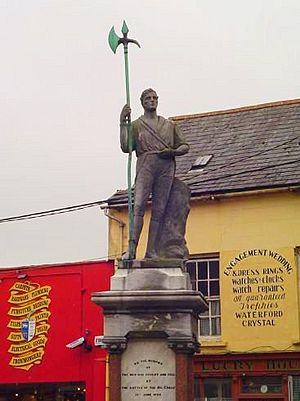
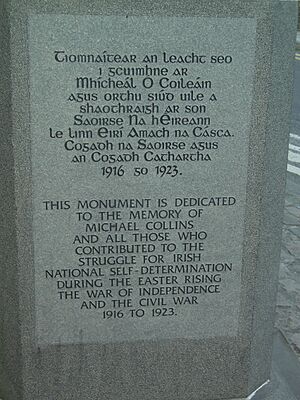
The area around Clonakilty has very old sites, some from before the Celts arrived. Norman people built castles here a long time ago. You can still find some Norman family names in West Cork today.
In 1292, a man named Thomas De Roach got permission to hold a market every Monday. This was near where Clonakilty is now. The name Clonakilty comes from the Irish words Cloch na gCoillte, which means "stone (or castle) of the woods."
How Clonakilty Became a Town
The lands around Clonakilty were owned by Richard Boyle, 1st Earl of Cork. He helped the town get its official charter from King James I in 1613. This charter gave Clonakilty the right to send members to the Irish Parliament.
During the Irish Rebellion of 1641, many Protestant settlers left Clonakilty, and parts of the town were burned. Later, in October 1642, a Protestant force took back the town. There was fighting, and some soldiers were killed. Eventually, the rebels were driven out.
The town was also part of a battle in 1691 during the Williamite War in Ireland. In 1798, a battle called the Battle of the Big Cross happened near Clonakilty. It was an important event in Munster during the Irish Rebellion of 1798. There's a statue in Clonakilty's Asna Square to remember this battle.
Michael Collins' Connection
Michael Collins, a very important Irish leader, lived in Clonakilty for a while. He went to the local boys' school. Collins was a key figure in the Irish War of Independence and helped create the Irish Free State.
He gave speeches from O'Donovan's Hotel in Clonakilty. Today, in Emmet Square, where Collins once lived, you can find a statue of him (put up in 2002) and a museum (opened in 2016) dedicated to his life.
Recent History
In 1943, a large American plane, a Boeing B-17 Flying Fortress, had to land in a marsh near Clonakilty. The crew thought they were over Norway!
Kennedy Gardens in Emmet Square is named after John F. Kennedy. In 2012, Clonakilty had some flooding. On May 5, 2013, the President, Michael D. Higgins, visited Clonakilty to celebrate 400 years since the town got its charter.
Churches in Clonakilty
There are several churches in Clonakilty:
- Kilgarriffe Church, a Church of Ireland church, was built in 1818.
- The Church of the Immaculate Conception is a large Catholic church. It was built in 1880 and has a beautiful Early French Gothic style.
- The old Presbyterian Church, built in 1861, has been used as a local Post Office since 1924.
- The local Methodist church was the first church in Ireland to win two Eco Congregation Ireland awards.
Getting Around Clonakilty
The closest airport is Cork Airport. You can catch a Bus Éireann coach from Clonakilty to Cork city and Skibbereen. In summer, there's also a bus to Killarney.
Clonakilty used to have a train station, which opened in 1886. It was part of the West Cork Railway. However, the railway closed down in 1961.
The town has a bypass road (the N71) that helps traffic go around the town centre.
Culture and Music Scene
Clonakilty is known for its lively music scene. Many bars in town have live music nights. Places like De Barra's Folk Club, Shanley's Music Bar, and O'Donovans are popular spots. De Barra's has hosted famous musicians like Christy Moore and Sharon Shannon.
Some well-known musicians and writers have chosen to live in the Clonakilty area. These include Noel Redding (from The Jimi Hendrix Experience), singer-songwriter Roy Harper, and novelist David Mitchell.
The town also hosts fun festivals every year. These include the Clonakilty International Guitar Festival in September and the Motion Festival and Waterfront Festival in August.
Awards and Recognition
Clonakilty has won many awards for being a great town:
- It won the Irish Tidy Towns Competition in 1999.
- It was named 'Ireland's Tidiest Small Town' in 2012, 2017, and 2022.
- In 2003, Clonakilty became Ireland's first-ever Fairtrade Town. This means it supports fair prices for producers in developing countries.
- In 2007, it was named a 'European Destination of Excellence' by the European Commission.
Population of Clonakilty
| Historical population | ||
|---|---|---|
| Year | Pop. | ±% |
| 1821 | 4,033 | — |
| 1831 | 3,807 | −5.6% |
| 1841 | 3,993 | +4.9% |
| 1851 | 3,297 | −17.4% |
| 1861 | 3,108 | −5.7% |
| 1871 | 3,568 | +14.8% |
| 1881 | 3,676 | +3.0% |
| 1891 | 3,221 | −12.4% |
| 1901 | 3,098 | −3.8% |
| 1911 | 2,961 | −4.4% |
| 1926 | 2,770 | −6.5% |
| 1936 | 2,961 | +6.9% |
| 1946 | 2,825 | −4.6% |
| 1951 | 2,742 | −2.9% |
| 1956 | 2,517 | −8.2% |
| 1961 | 2,417 | −4.0% |
| 1966 | 2,422 | +0.2% |
| 1971 | 2,430 | +0.3% |
| 1981 | 2,698 | +11.0% |
| 1986 | 2,786 | +3.3% |
| 1991 | 2,812 | +0.9% |
| 1996 | 2,970 | +5.6% |
| 2002 | 3,698 | +24.5% |
| 2006 | 4,154 | +12.3% |
| 2011 | 4,721 | +13.6% |
| 2016 | 4,592 | −2.7% |
| 2022 | 5,112 | +11.3% |
According to the 2022 census, Clonakilty had about 4,994 people living there. Most residents were born in Ireland. People from many different backgrounds live in Clonakilty, making it a diverse town.
Local Food
Clonakilty is famous for its delicious black pudding. This special pudding first came from Edward Twomey's butcher shop in the 1880s. The secret recipe for its spices has been passed down through the Twomey family for generations. The Clonakilty Food Company still makes it today!
Fun Things to Do in Clonakilty
- The Model Village: This is a popular place to visit! It has tiny, fully scaled models of Clonakilty and nearby towns. You can see them built along a miniature railway line.
- Michael Collins House: This museum is all about the Irish leader Michael Collins. It's in a restored old house where he lived from 1903 to 1905. The museum shares his life story and the history of Irish independence through tours and displays.
- Festivals: Clonakilty hosts fun events like the "Random Acts of Kindness Festival" in July and the Clonakilty Street Carnival in June. The carnival has live music and lots of activities.
- Clonakilty Museum: Learn more about the town's past here.
- Farmers Market: Every Friday, you can visit the Farmers Market in Emmet Square to find fresh local produce and goods.
Education in Clonakilty
Clonakilty has several schools:
- Secondary Schools: Clonakilty Community College (for both boys and girls) and Sacred Heart Secondary School (for girls only).
- Primary Schools: There are four primary schools in the town.
- Agricultural College: Clonakilty Agricultural College, also known as Darrara College, is just outside town. It teaches students about farming.
Sports in Clonakilty
Clonakilty has many sports clubs for young people to join:
- GAA: The Clonakilty GAA club plays Gaelic football and hurling. Their football team won the Cork Senior Football Championship in 1996 and 2009.
- Soccer: There are two soccer clubs: Clonakilty A.F.C. and Clonakilty Town.
- Rugby: Clonakilty R.F.C. is the local Rugby union club.
- Martial Arts: The Warrior Tae Kwon Do club teaches taekwondo, Kickboxing, and Freestyle Fighting. Students from this club have even become World Champions!
Beautiful Beaches Nearby
Clonakilty is close to some lovely beaches:
- Inchydoney Island: This is the closest Blue Flag beach, meaning it's very clean and safe. It's just south of the town.
- Long Strand: About 11 kilometers from Clonakilty, this sandy beach is about a mile and a half long. It's a great spot for walks and looking out at the Galley Head lighthouse.
- Duneen Beach: You can find this beach across the bay from Inchydoney beach.
Town Twinning
Clonakilty has special friendships with two towns in other countries:
 Chateaulin, Brittany, France (since 1986)
Chateaulin, Brittany, France (since 1986) Waldaschaff, Bavaria, Germany (since 1989)
Waldaschaff, Bavaria, Germany (since 1989)
Famous People from Clonakilty
Many interesting people have connections to Clonakilty:
Born in Clonakilty
- Peter Callanan: A politician who was a senator.
- Tadhgo Crowley: A footballer who captained a team that won the All-Ireland Senior Football Championship in 1945.
- Alfred Elmore: A Victorian artist.
- William Harnett: An Irish-American artist.
- Máire Ní Shíthe: An Irish language writer.
- Mary Jane O'Donovan Rossa: A poet and political activist.
- Louise O'Neill: A well-known author.
Lived in Clonakilty
- Michael Collins: A very important Irish leader, born nearby and lived in the town.
- Roy Harper: A famous singer-songwriter.
- David Mitchell: A well-known novelist.
- Noel Redding: A musician, famous for being in The Jimi Hendrix Experience.
- Joseph Walsh: A politician who was a Minister for Agriculture.
See also
 In Spanish: Clonakilty para niños
In Spanish: Clonakilty para niños



